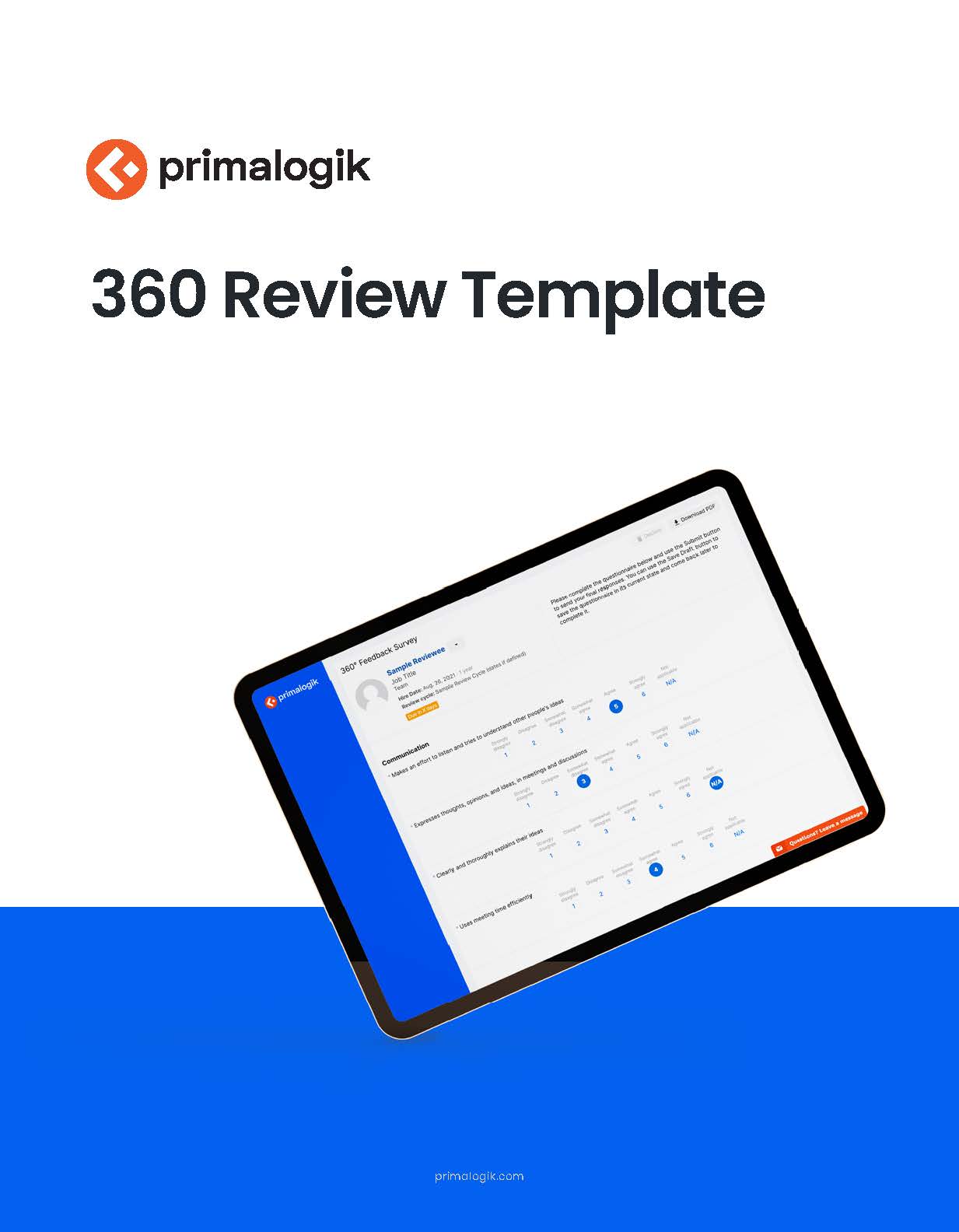Upward feedback is input shared with managers and leaders by employees. While we often think of sharing feedback as being a boss’s job, feedback from direct reports to managers is also crucial. We’ll first discuss why upward feedback is so important to leaders’ growth and companies’ success. Then, we’ll explore strategies for promoting upward feedback in your organization.
Table of Contents
- The Importance of Upward Feedback
- Challenges in Providing Feedback to Managers
- Tips for Employees: Giving Effective Upward Feedback
- The Role of HR in Upward Feedback
- Facilitate Upward Feedback with Primalogik
- FAQs about Upward Feedback
The Importance of Upward Feedback
Getting honest feedback is crucial to leaders’ growth. And direct reports have the most relevant insights on their leadership approach. After all, team members have more familiarity with their coaching and communication style than anyone else in the organization.
Receiving feedback at work makes people 89% more likely to thrive. Plus, it increases engagement by 63% and job satisfaction by 79%, reports Berkeley Greater Good. If leaders aren’t receiving feedback, they’re missing out on these crucial benefits.
However, leaders often operate in a “feedback vacuum,” as Brodie Gregory Riordan says in Feedback Fundamentals and Evidence-Based Best Practices. The higher they advance, the less feedback they receive—even though they need to be critiqued to enhance their self-awareness and help them lead more effectively. These observations can also strengthen their relationships with direct reports.
Making sure senior employees gain this feedback will help the whole business function more smoothly, too. As leaders learn how to become better coaches and mentors, teams will become capable of achieving higher goals.
Challenges in Providing Feedback to Managers
Sharing upward feedback can feel daunting due to power differences between employees and leaders. Let’s examine the main barriers to providing feedback to leaders.
Uncertainty about How to Phrase Feedback
Employees often feel unclear about how to phrase upward feedback effectively. Because of this uncertainty, they may feel awkward about delivering it.
Perception of Leaders as Unapproachable
Employees may perceive leaders as unwilling to hear criticism or take steps to change. Managers may unintentionally come across as aloof or disinterested in hearing input from direct reports.
Fear of Retaliation or Negative Consequences
Employees may fear sharing honest feedback will jeopardize their relationship with their manager. They may worry managers will retaliate by withholding opportunities, mentoring, or other support.
HR can help relieve the anxiety associated with upward feedback by encouraging leaders to welcome it, as we’ll discuss in a moment.
Tips for Employees: Giving Effective Upward Feedback

HR can share these best practices with employees to help them give feedback to leaders.
Ask First
Ask if you can share some feedback. When you ask for consent to begin the conversation, it creates a more constructive climate. Set up a time to meet one-on-one, and be clear about the topic you want to discuss. For example, you can say, “I’d like to share some input on yesterday’s meeting,” as Tijs Besieux says in Harvard Business Review.
Choose the Right Timing and Setting
It’s usually best to share feedback with your manager fairly quickly—ideally, within a couple of days. At the same time, it’s important to first pause to reflect on what happened and consider your words. Set up a time for a private conversation about the issue you want to discuss.
Offering observations through a 360 feedback process organized by HR can also allow you to share clear, well-thought-out insights. If you’ve avoided sharing feedback for a long time, this process can let you provide input in a structured way that feels more comfortable.
Be Constructive and Specific
To clearly share feedback, use the CORE method that Radical Candor provides:
- Context (describe the situation)
- Observation (explain what happened)
- Result (tell how it affected you)
- Expected next steps (state what you hope your manager will do)
This technique allows you to concisely convey what happened and why it matters. This is very similar to the situation-behaviour-impact model—another highly useful method—except that it adds a discussion of next steps.
Bring Questions
Rather than assuming you’re right, ask insightful questions. If you’re critiquing a decision made by your boss, ask about the rationale behind it. Make sure your questions are genuine, tailored to increasing your understanding of the situation. This will also give you more empathy for your boss, as Brandi Neal says on Radical Candor.
Focus on Behaviours, Not Personalities
Don’t speculate about the motives guiding the behaviour or critique your manager’s personality. Instead, focus on what actually happened and how it affected you. By prioritizing objectivity, you’ll minimize defensiveness and help the conversation flow smoothly.
Frame It as an Effort Toward Growth
Show empathy and understanding as you deliver feedback, and frame the conversation as a collaborative effort toward mutual growth. You can say, for instance, “I know you’re invested in growing as a supervisor, and I think this input will contribute to that goal.” And assume their intentions were good, as Neal says.
Examples of Upward Feedback
Here are a few examples of how to tactfully share feedback with your boss:
- “During yesterday’s meeting, I was interrupted before I could fully share an important thought. Then the conversation shifted and I didn’t get to share details that I felt were crucial to the project. I understand that meetings can be dynamic, but perhaps we could try a hand-raising system, or having a brief pause for questions after each person shares?”
- “When you shared instructions for assignment X the other day, I didn’t fully grasp all the details. Since there wasn’t an opportunity to ask questions right away, I had a tough time getting started. Going forward, it would be really helpful to have a quick check-in after complex instructions to ensure understanding.”
- “When choosing the lead for project XYZ, I noticed that Bob was selected very quickly. This left me feeling a bit frustrated and concerned that others, myself included, might be missing out on opportunities to develop our leadership skills. I think it would benefit the team’s growth if these opportunities were distributed more evenly. Perhaps we could try a rotation system?”
Such statements focus on behaviours, following the CORE method discussed above.
The Role of HR in Upward Feedback
HR should play a key role in ensuring all leaders receive upward feedback. Let’s discuss the full spectrum of ways in which HR can do this.
Facilitate the Process
Design and implement a structured upward feedback system. Begin by choosing a 360 feedback software and creating a schedule for conducting these surveys. Also specify who will complete the 360 survey for each person. Include all direct reports in their manager’s survey, as well as a sampling of peers, senior leadership, and people more than one level below (if applicable).
Prompt managers to seek feedback face-to-face, too. Challenge them to ask for constructive criticism during one-on-ones, for example.
Provide Training and Support
Educate employees and managers on how to give and receive feedback, sharing the above advice on delivering feedback with them. And prompt managers to actively seek out constructive criticism. Introduce the radical candor approach, training employees and leaders on how to use it in giving and receiving feedback.
Guide managers in fostering a sense of psychological safety in sharing feedback. Managers can have a “go-to question” that prompts detailed feedback, for instance. A good question lowers the sense of risk linked to speaking honestly, showing they genuinely want the input. “What is one thing I can do to better support you?” is one example of a go-to question. Bring this question regularly to your one-on-ones, and people will start showing up prepared to share insights, as Kim Scott and coauthors say in Harvard Business Review.
Ensure Confidentiality and Anonymity
Encourage honest and open communication by protecting the identity of those sharing feedback in tools like 360 reviews. Assure employees their responses will remain anonymous, allowing them to speak more freely.
Analyze and Utilize Feedback
Collect and analyze data to identify trends and areas for improvement. Good 360 review software will synthesize a leader’s results and highlight patterns. After distilling these insights, talk with them and create a plan for growth focused on several key areas.
Promote a Feedback Culture
Encourage regular and ongoing feedback in all directions—upward, downward, and horizontally. As managers solicit insights from employees, they’ll model how everyone can do the same. These requests for feedback will build trust and increase employees’ comfort with sharing as well as receiving input. Remind leaders to share gratitude for the feedback, which is often difficult for direct reports to give.
Facilitate Upward Feedback with Primalogik

You can leverage Primalogik, a comprehensive performance management solution, to gather regular upward feedback for leaders. Primalogik’s software includes both 360 reviews and a tool that supports the sharing of real-time feedback.
Multiple key features of Primalogik’s software facilitate upward feedback:
- Customizable leadership assessment templates and questionnaires for 360 reviews.
- Automated feedback collection and analysis.
- Anonymous feedback options to ensure honest responses.
- Actionable insights and reports that allow you to track progress.
Primalogik’s tool can prompt teams to complete an assessment of their manager and then synthesize the results. Through such functions, Primalogik will help HR streamline the upward feedback process, saving time, improving efficiency, and strengthening the quality of the data you receive.
Using 360 feedback software will ensure managers gain clear and detailed input on the most relevant topics. By facilitating the sharing of anonymous feedback, it will help employees feel more comfortable speaking openly.
Adopting the right tools will encourage people to regularly share upward feedback. Primalogik’s comprehensive suite of performance management tools will facilitate this process. It includes 360 reviews that solicit detailed feedback on leaders’ effectiveness, as well as an instant feedback-sharing tool.
FAQs about Upward Feedback
We share our answers to a few common questions on this important topic.
How do I give feedback to a leader without offending them?
First, ask for permission to share input. Then, provide specific observations focused on behaviours, not personality. Affirm you’re sharing the feedback because you believe it will benefit the leader’s growth.
What’s the best way to phrase critical feedback for a manager?
Take an empathetic approach, acknowledging you know your manager strives to be a supportive leader. Then, share a clear and specific observation—ideally, of something that happened within the last several days. Focus on behaviours rather than critiquing their personality.
Are anonymous feedback tools effective for upward feedback?
Yes, anonymous tools can gather upward feedback while reassuring employees their identity will remain protected. For example, Primalogik offers anonymous survey tools that can be used to gain insights on leaders’ effectiveness.
As employees grow more comfortable sharing upward feedback, leaders will gain valuable input that enhances their growth. Continue reminding both employees and managers of the vital importance of upward feedback and discussing strategies for delivering it effectively. These efforts will strengthen both your organizational culture and what your company is capable of achieving.
Learn how the right tools can support the sharing of effective upward feedback—demo our performance management software!





